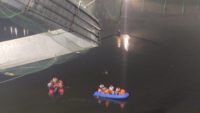Though work is expected to resume in about five weeks, the Dec. 24 collapse of a 50-meter-long portion of an unfinished, 1,100-m-long cable-stayed bridge, some 50 m above the river Chambal near Kota in Rajasthan, has left the National Highway Authority of India baffled. The accident killed more than 45 people. Many others still are missing.

The $65-million project, 310 miles from New Delhi, consists of a 700-m-long cable-stayed structure with a 350-m main span and an access viaduct on either end. Hyundai Engineering & Construction Co. Ltd. and Gammon India are the main contractors. The bridge was designed by Systra-MVA Consulting India, a French-owned company. Systra’s contract includes supervision of the geometry for the bridge during construction. Casting of concrete for the main span had begun in late June, and work on the two pylons and lateral spans was under way.
NHAI has formed a committee to investigate the cause. This is, “prima facie, a case of human negligence with little possibility of technical fault or of design,” Subash Patel, director of NHAI’s technical board, told reporters at the site.
Completion of the concrete bridge, which was scheduled for later this year, will be delayed until 2011, says NHAI. When done, it will be the first axial suspension cable-stayed bridge in India. “We express our trust and confidence in the [contractors’] capacity,” said Patel, who added, “The same companies will carry on the work.”
Hyundai refused to comment on the collapse. Other sources also declined to describe the sequence of events or offer details about the collapsed portions.
Rohit Modi, deputy managing director of Gammon, said at a press conference that the agreement was for Hyundai to construct 65% of the bridge and Gammon the remaining 35%. “But it does not mean that Gammon had less responsibility,” he said. “We take moral responsibility for the accident,” he added.
“There were definitely some lapses in construction, which will be revealed after investigation,” said Modi, adding that both companies had lost $26 million following the tragedy.
Gammon India also was involved in a recent construction failure on an extension to the Delhi Metro. That mishap involved a design flaw and inadequate concrete curing, according to a government report (ENR 8/3/09 p. 13).
“There is no apparent problem with the design [of the bridge]. It was thoroughly proof-checked,” says Anil Lal, Systra’s managing director. “It is too early to say what the reason is for the mishap,” he added.
The bridge deck consisted of a single- cell box girder 30.2-m wide, stiffened every 3.5 m by transverse ribs. Two 1.5-m-wide footpaths run along the sides.
Before work can resume, crews must remove 8,000 tonnes of concrete that fell into the river, said Modi.


